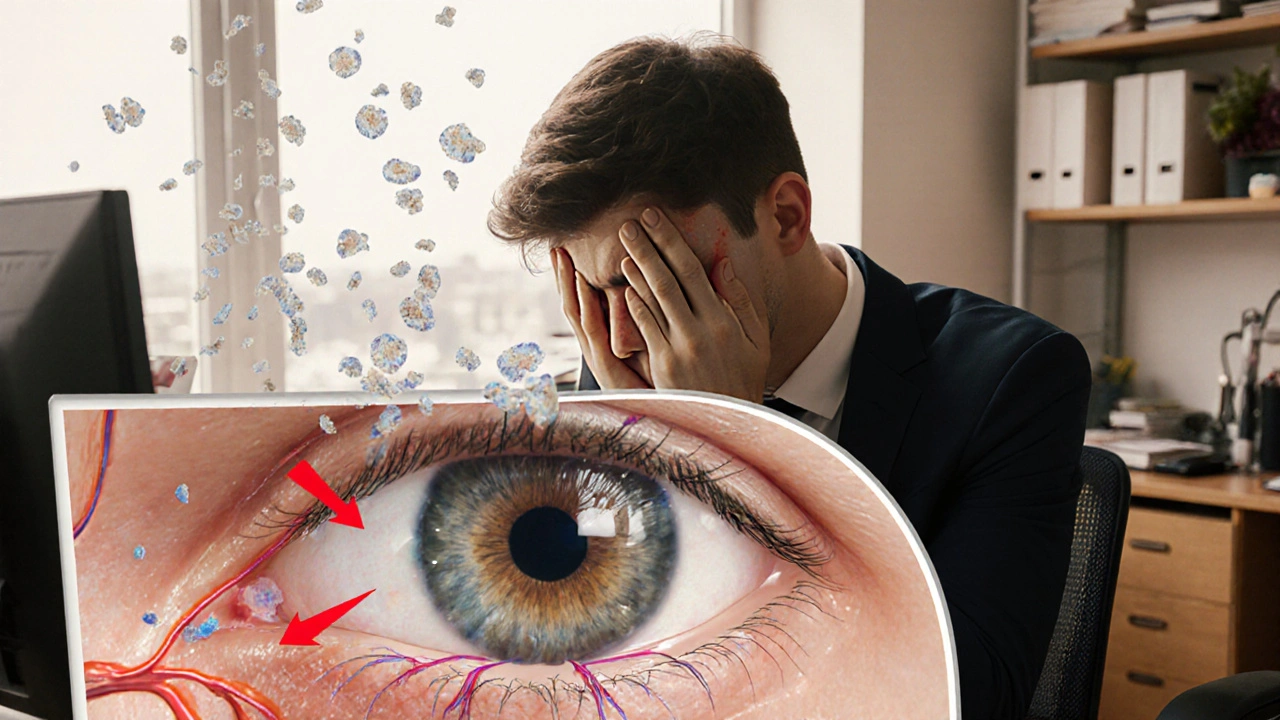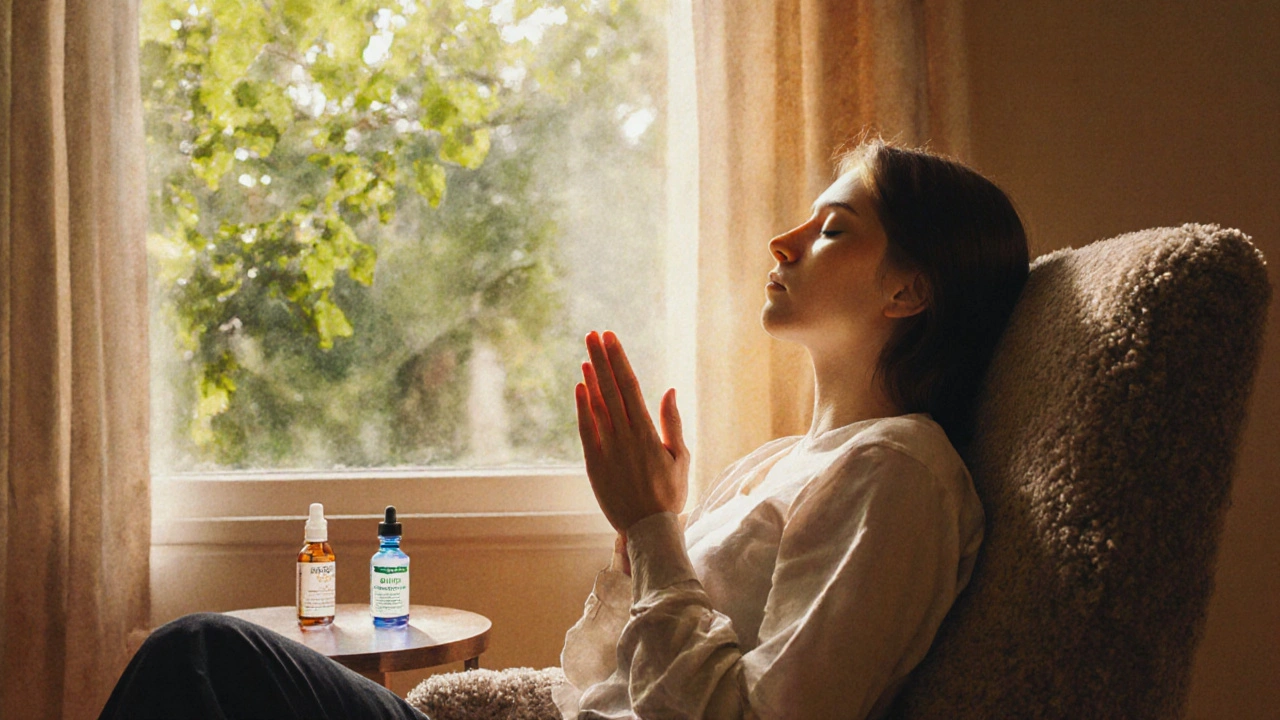How Stress Worsens Allergic Conjunctivitis Symptoms
 Sep, 27 2025
Sep, 27 2025
Allergic conjunctivitis is an eye inflammation caused by an allergic response to airborne allergens such as pollen, dust mites, or animal dander. It shows up as red, itchy, watery eyes and often comes with sneezing or a runny nose. While the allergy itself drives the reaction, the severity can jump dramatically when a person is under psychological pressure.
Why Stress Matters for the Eyes
Stress is a physiological and emotional response to perceived threats or demands. When stress spikes, the body releases cortisol and activates the sympathetic nervous system, which in turn modulates immune activity. This cascade isn’t limited to the brain; it reaches the ocular surface, making the eyes a frontline for stress‑related flare‑ups.
Stress and the Immune System: The Hormone Connection
Cortisol, the primary stress hormone, normally dampens inflammation. Chronic stress, however, leads to cortisol resistance-cells stop listening to its calming signal. The result is unchecked histamine release from mast cells, amplified cytokine production, and a leaky ocular surface barrier.
Studies from the American Academy of Ophthalmology (2023) show that people reporting high perceived stress have a 45% higher odds of moderate‑to‑severe allergic conjunctivitis compared to low‑stress counterparts. The link isn’t just correlation; lab work shows that stress‑induced sympathetic signals increase the expression of IgE receptors on mast cells, priming them for a stronger reaction when allergens arrive.
Pathophysiology of Allergic Conjunctivitis
The ocular surface is lined by the conjunctiva, a thin, vascularized membrane that houses immune cells. In a sensitized individual, exposure to an allergen cross‑links IgE on mast cells, prompting an immediate stress allergic conjunctivitis surge of histamine, leukotrienes, and prostaglandins. Within minutes, blood vessels dilate, nerves fire, and tear production spikes.
Two phases follow:
- Early phase (minutes): Histamine‑driven itching, redness, and watery discharge.
- Late phase (hours): Recruitment of eosinophils and cytokines such as IL‑4, IL‑5, and IL‑13, which sustain swelling and can lead to conjunctival hyperemia lasting days.
When stress is present, the early phase intensifies-more histamine is released, and the late phase prolongs, because cortisol can no longer keep the cytokine storm in check.
How Stress Amplifies Symptoms
Three main mechanisms explain the amplification:
- Barrier disruption: Stress reduces mucin production by goblet cells, thinning the tear film and allowing allergens easier access to the conjunctiva.
- Immune priming: Sympathetic signaling up‑regulates FcεRI receptors on mast cells, making them hypersensitive even to low allergen loads.
- Cytokine synergy: Chronic cortisol resistance elevates baseline levels of IL‑6 and TNF‑α, which act as adjuvants, magnifying the allergic response.
Real‑world example: a college student juggling exams reported that their usual mild pollen‑induced itching turned into relentless burning eyes during finals week. Objective monitoring showed a 30% rise in tear histamine concentrations compared to non‑stress periods.
Clinical Presentation Under Stress
Patients often describe a “flare‑up” that feels out of proportion to the environmental trigger. Typical signs include:
- Intense itching that compels rubbing, worsening epithelial damage.
- Swollen, blood‑shot eyes that persist beyond the allergen exposure window.
- Increased photophobia due to heightened corneal nerve sensitivity.
- Concurrent nasal symptoms (allergic rhinitis) that peak during high‑stress periods.
Because stress can mask underlying triggers, clinicians should ask about recent life events, sleep quality, and caffeine intake when assessing severity.

Managing Stress‑Driven Exacerbations
Effective control blends stress‑reduction tactics with targeted eye therapy. Below are evidence‑backed steps:
- Identify stressors: Use a simple diary to log mood, work load, and symptom spikes.
- Mind‑body practices: Daily 10‑minute breathing exercises reduce sympathetic tone, cutting cortisol spikes by ~20% (Harvard Health, 2022).
- Optimize sleep: Aim for 7‑9 hours; sleep deprivation raises IgE levels by up to 15%.
- Limit caffeine & alcohol: Both can increase histamine release from mast cells.
- Pharmacologic relief: Choose eye drops based on the predominant phase (see comparison table).
When pharmacologic therapy is needed, the two most common first‑line options are antihistamine eye drops and mast‑cell stabilizers. Both have distinct onset times, duration of action, and side‑effect profiles.
Comparison of Common Eye Treatments
| Attribute | Antihistamine Drops | Mast‑Cell Stabilizers | Combined (Dual‑Action) |
|---|---|---|---|
| Onset | 1-5minutes | 15-30minutes | 1-5minutes (histamine) / 15minutes (stabilizer) |
| Duration | 4-6hours | 8-12hours | 12hours (dual) |
| Best for | Acute itching | Preventive control | Both acute and chronic flare‑ups |
| Common Side Effects | Transient stinging | Mild burning, rare allergic reaction | Combination of above |
| Cost (US) | $15-$30 (OTC) | $20-$45 (OTC) | $30-$55 (prescription) |
When stress is a known trigger, many ophthalmologists prefer a dual‑action drop. The antihistamine component tames the immediate itch, while the stabilizer prevents the late‑phase cytokine surge that stress would otherwise magnify.
Related Concepts and Broader Context
Allergic conjunctivitis does not exist in isolation. It often accompanies other atopic conditions such as allergic rhinitis and atopic dermatitis. These comorbidities share the same IgE‑mediated pathways, meaning stress that fuels eye symptoms can simultaneously worsen nasal congestion and skin itching.
Beyond symptom control, immunotherapy-either sublingual tablets or allergy shots-offers a disease‑modifying route. By gradually desensitizing mast cells, immunotherapy reduces the overall allergic load, making stress‑induced spikes less dramatic.
For readers seeking a deeper dive, the next logical topics are:
- "How Sublingual Immunotherapy Works for Ocular Allergies"
- "Dietary Antioxidants and Their Role in Reducing Eye Inflammation"
- "Technology‑Based Stress Monitoring for Allergy Management"
TL;DR - Quick Takeaways
- Stress raises cortisol resistance, leading to more histamine and a weaker barrier on the eye.
- Symptoms can become 2-3 times worse during high‑stress periods.
- Mind‑body techniques, adequate sleep, and reduced caffeine cut the stress‑allergy loop.
- Dual‑action antihistamine+mast‑cell stabilizer drops are most effective for stress‑driven flare‑ups.
- Consider immunotherapy for long‑term reduction of both eye and nasal allergies.
Frequently Asked Questions
Can everyday stress really trigger eye allergies?
Yes. Even mild emotional strain can raise cortisol and sympathetic activity, which in turn makes mast cells on the conjunctiva more likely to release histamine. The result is a noticeable jump in itching, redness, and tearing compared to a non‑stress state.
Do antihistamine eye drops work if I’m stressed?
They help with the immediate itch, but stress can keep the late‑phase inflammation alive. For best results during stressful periods, combine an antihistamine with a mast‑cell stabilizer or use a dual‑action formula.
Is there a way to test if stress is worsening my eye allergy?
Track symptoms alongside a simple stress questionnaire (e.g., Perceived Stress Scale). If peaks in the score line up with eye flare‑ups, you have a strong correlation. Some eye clinics also measure tear histamine levels before and after a stress‑reduction intervention.
Can lifestyle changes replace medication?
Lifestyle tweaks-regular sleep, stress‑relief exercises, limiting caffeine-can dramatically lower flare‑up frequency, but they rarely eliminate the need for eye drops during high‑allergen seasons. A combined approach offers the smoothest relief.
Is immunotherapy safe if I’m already stressed?
Immunotherapy is safe for most adults, regardless of stress levels. In fact, by lowering overall IgE sensitivity, it can make the immune system less reactive to the hormonal swings that stress causes.

Andrew Buchanan
September 27, 2025 AT 16:02While the link between stress hormones and ocular inflammation is well‑documented, it is advisable to monitor stress levels alongside allergy treatments.
Krishna Chaitanya
September 28, 2025 AT 11:29Wow the eyes burn like a wildfire when finals hit the brain feels like a volcano exploding
diana tutaan
September 29, 2025 AT 06:55The article overstates the impact of cortisol resistance; most patients see only marginal changes in symptom severity.
Sarah Posh
September 30, 2025 AT 02:22Great summary! Remember that small daily breathing exercises can genuinely lower that stress‑triggered itch without any extra cost.
James Knight
September 30, 2025 AT 21:49Sure, but breathing tricks won’t fix the underlying immune chaos; you’re just putting a band‑aid on a broken system.
Ajay D.j
October 1, 2025 AT 17:15In many South Asian households, meditation is already a part of daily routine, making it easier to adopt stress‑reduction habits for eye health.
Dion Campbell
October 2, 2025 AT 12:42One must acknowledge that the presented data, though adequate, lacks the nuanced analysis expected from a thorough ophthalmological discourse.
Burl Henderson
October 3, 2025 AT 08:09Indeed, the discussion could benefit from integrating cytokine profiling metrics and pharmacokinetic modelling to substantiate the proposed mechanisms.
Leigh Ann Jones
October 4, 2025 AT 03:35The piece attempts to bridge psychoneuroimmunology with ophthalmology, a commendable ambition that nevertheless falls short in several respects.
First, the introduction glosses over the fundamental biochemistry of cortisol, assuming the reader possesses prior knowledge that may not exist.
Second, the citation of the 2023 American Academy of Ophthalmology study lacks critical appraisal of its methodology, such as sample size and confounding variables.
Third, the article posits a direct causal chain between stress and mast‑cell hyper‑responsiveness without acknowledging the substantial inter‑individual variability observed in clinical practice.
Moreover, the suggested stress‑diary approach, while useful, is presented as a universal solution, ignoring cultural and socioeconomic barriers that limit its feasibility.
The discussion of dual‑action eye drops is thorough, yet the cost analysis fails to consider insurance coverage disparities across different health systems.
In addition, the narrative could have explored alternative therapeutic avenues, such as omega‑3 supplementation or antihistamine‑free formulations, which are gaining traction in recent trials.
The table comparing pharmacologic options is clear, but the omission of side‑effect profiles for long‑term use undermines its practical utility.
While the author highlights mind‑body techniques, the recommendation of “10‑minute breathing exercises” is overly simplistic and lacks citation of efficacy data.
It would have been beneficial to integrate a brief overview of autonomic nervous system modulation as it pertains to ocular surface homeostasis.
Furthermore, the article neglects to address comorbidities like atopic dermatitis, which often exacerbate ocular symptoms in a synergistic manner.
A deeper dive into the role of goblet cell mucin production under stress could illuminate potential targets for future drug development.
The concluding “TL;DR” summary serves as a handy recap, yet it repeats points already made without offering novel actionable insights.
Overall, the manuscript provides a solid foundation but requires more rigorous scrutiny of the cited literature.
Readers seeking evidence‑based guidance would benefit from a more balanced portrayal of both the strengths and limitations of current research.
In sum, the article is a step in the right direction but stops short of delivering the comprehensive analysis that the topic demands.
Sarah Hoppes
October 4, 2025 AT 23:02They don’t want you to know that big pharma funded the stress study
Robert Brown
October 5, 2025 AT 18:29This article is a half‑baked hype dump.
Erin Smith
October 6, 2025 AT 13:55Even if it’s rough the info can still help people manage their eyes
George Kent
October 7, 2025 AT 09:22Honestly, the author completely misrepresents the data, fails to cite peer‑reviewed sources, and ignores the fact that stress‑induced eye conditions are more prevalent in Western societies 🇺🇸-a glaring oversight, indeed! 📊🙄
Jonathan Martens
October 8, 2025 AT 04:49Sure, because throwing around terms like “cortisol resistance” automatically makes the piece scientifically superior, right?
Jessica Davies
October 9, 2025 AT 00:15It’s absurd to accept that a simple stress diary could rival controlled clinical trials, yet many do.
Kyle Rhines
October 9, 2025 AT 19:42Note the lack of proper citation; this is typical of pseudo‑scientific narratives.
Lin Zhao
October 10, 2025 AT 15:09Interesting points! 🌟 Could anyone share personal experiences on how meditation has changed their eye allergy symptoms?